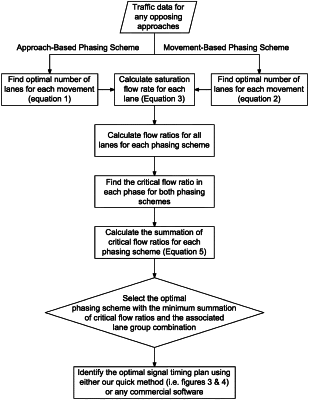| CPC G08G 1/09 (2013.01) | 13 Claims |

|
1. A method for determining space allocation and signal timing for traffic flow in a plurality of traffic lanes of an isolated signalized intersection of two roads, each road comprising parallel opposing traffic lanes, comprising:
wherein at least one remote server comprises a plurality of traffic-related data of the traffic flow of the isolated signalized intersection, wherein the traffic flow comprises a plurality of phases and wherein each of the phases of the plurality of phases is a directional right of way movement and wherein the traffic-related data includes a volume of vehicles at the isolated signalized intersection;
receiving the plurality of traffic-related data through a processing module, wherein the processing module is communicably coupled with the at least one remote server;
calculating, through the processing module, a set of traffic flow rates for each phase of the plurality of phases, wherein each of the set of traffic flow rates corresponds to a traffic lane of the isolated signalized intersection;
determining, through the processing module, a critical flow rate for each of the plurality of phases by identifying a maximum traffic flow rate of the set of traffic flow rates, wherein the maximum traffic flow rate of each of the plurality of phases is the critical flow rate corresponding to that phase;
determining a first critical flow summation by summing the critical flow rate of each of the plurality of phases associated with an approach-based phasing scheme, wherein the approach based phasing scheme is configured to at least control traffic movement headed towards at least a left direction, a right direction, and a straight direction;
determining a second critical flow summation by summing the critical flow rate of each of the plurality of phases associated with a movement-based phasing scheme, wherein the movement-based phasing scheme is configured to at least control traffic movement of opposite directions;
comparing the first critical flow summation with the second critical flow summation to find a minimum critical flow summation; and
selecting the approach-based phasing scheme as a phasing scheme based on the comparison indicating that the first critical flow summation is the minimum critical flow summation.
|